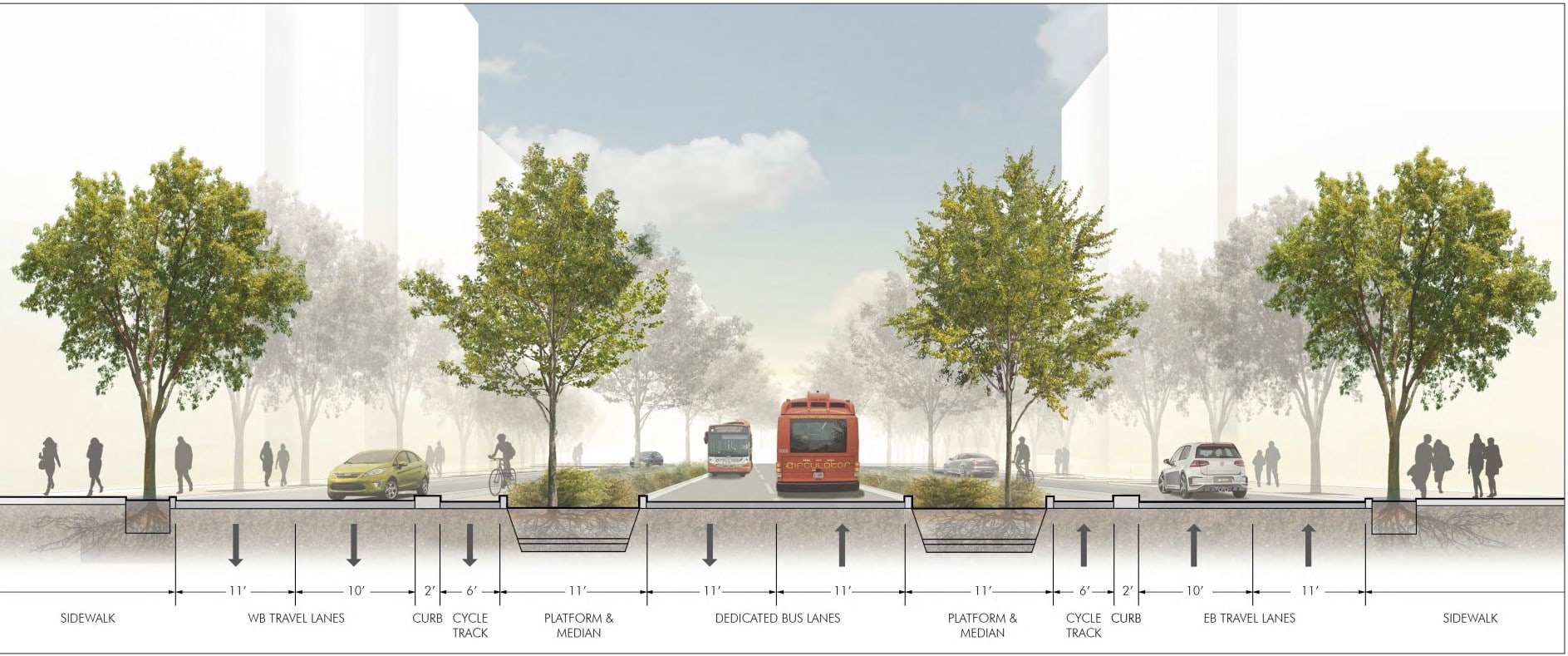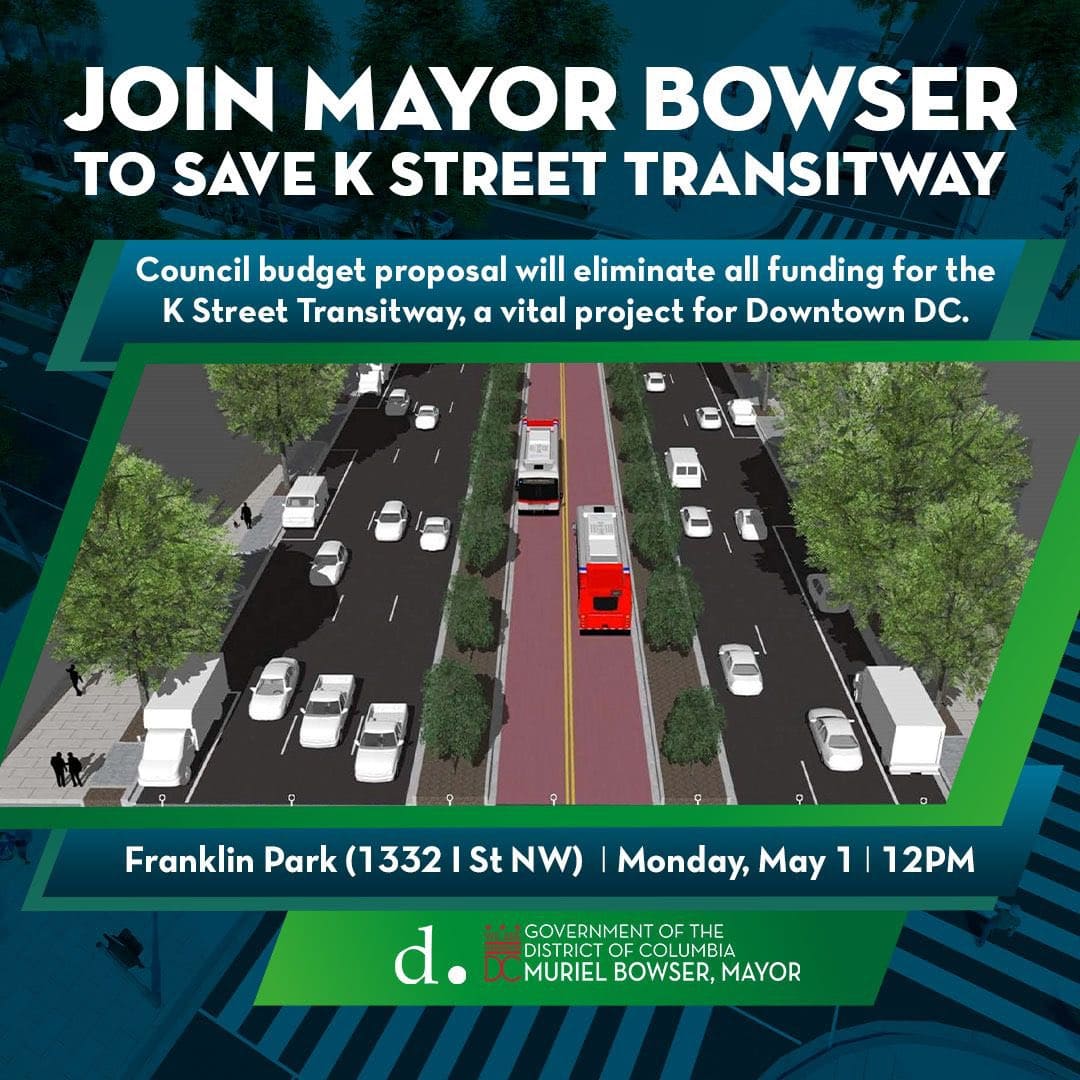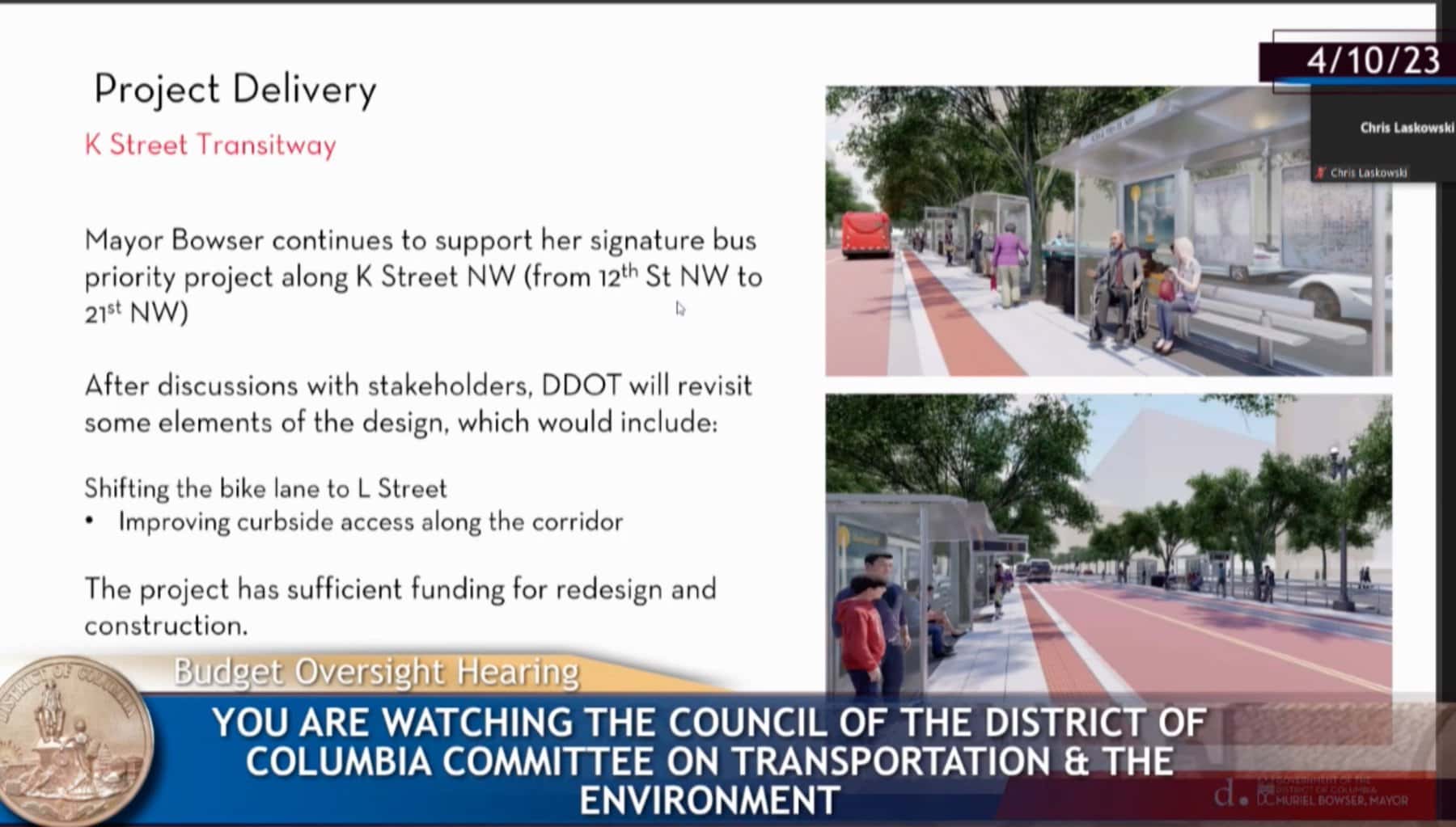Everyone is talking about the $115 million reconstruction project on K Street NW this week. Depending on who you talk to, the last-minute design changes will either speed up the downtown corridor’s recovery or sink it further into obscurity by doubling down on cars and highways in the urban core. With so many hot takes flying around, we wanted to take a moment to untangle the project and share why WABA supports delaying the reconstruction of K Street NW and a return to the design table.
What Happened?
In 2019, DDOT officially launched a long-discussed plan to reconstruct K Street NW from 11th Street to 22nd Street NW with a new center-running busway, new protected bike lanes, new and wider sidewalks, lush and sustainable landscaping, and four driving lanes. The project was far from perfect, but it ticked the most critical boxes: speed up bus service, stitch together the downtown bike network, protect pedestrians, and calm traffic. By December 2022, after years of community engagement and planning discussions, engineering plans were 100% complete and the project was ready to advertise for construction beginning this year.

But in April, DDOT announced a surprise new design that removes the bike lanes entirely from K Street and replaces them with yet another lane for cars at the Mayor’s behest. As a meager consolation, DDOT promised upgrades to the existing L Street protected bike lanes to feature a new two-way design. DDOT claims it can fully update the design plans in three months and move the project to construction.

Bottom Line
The Mayor’s new design for K Street, without protected bike lanes, is not right for DC’s future. It puts cars and the “motorist experience” first, second, and third in a project that was conceived and developed to prioritize transit users, pedestrians, and bicyclists. Yes, the new design will improve bus service with dedicated lanes, but it also keeps a five to seven lane highway through the heart of downtown DC.
This street will be loud. It will be congested during daytime and be a dangerous raceway at night when empty. It will remain difficult and stressful to cross the street or to the bus stops in the middle of this urban highway. And it pretends to accommodate people on bikes and scooters by sending them somewhere else, leaving a forever no-go-zone in the bicycle network in the heart of the city.
The Mayor’s 11th-hour redesign sacrifices the safety and comfort of people walking, biking, and taking transit for the convenience of people driving. That’s an unacceptable tradeoff. It works against the District’s Vision Zero safety goals, contradicts the recommendations of the MoveDC Long Range Transportation Plan, and will set back DC’s efforts to shift people out of private cars by locking in a car-centric design for decades to come.
Studies from all over the country show that in addition to being safer for everyone—including people in cars—Complete Streets are better for business than streets that prioritize driving and parking. We therefore agree with the Council’s request to send this project back to the planning stages.
How We Got Here
In April 2019, Mayor Bowser stood in Farragut Park to announce a bold project to reimagine K Street NW for the 21st century “with dedicated bus lanes, protected bike lanes, redesigned sidewalks, and safer intersections to help keep DC moving and growing.” The plan built on an approved but unrealized 2009 vision for a K Street center-running busway, with the major addition of protected bike lanes. With construction set to begin just one year later, we were not sure how it would all come together in so little time. But, excited about a truly complete street at the center of downtown DC, WABA and many safe streets advocates pulled a chair to the table to help work it out.
By late 2019, DDOT had produced detailed renderings of two possible bike lane designs. WABA endorsed the center-running design (read our letter) because it avoids conflicts with the dozens of driveways, right turns, and loading bays. This configuration was the most likely to make it all the way through an accelerated design process without compromising bicycle and pedestrian safety.
The timeline obviously shifted, but over the next three years, through a dozen public meetings and stakeholder discussions, DDOT advanced the design process. As it progressed from artistic concepts, to 30% design, 60% design, and onto 90% engineering drawings, the broad details stayed constant: center bus lanes, safer pedestrian crossings, protected bike lanes, and new sidewalks. But the fine details shifted sharply to the utilitarian. Landscaping became hard concrete edges, a new median tree canopy became low hedges, and existing mature trees became new plantings.
Many following the project closely from the start began to question whether it would actually deliver the promised vibrant atmosphere for sidewalk cafes, walking and rolling. In addition, construction would be very disruptive over three years. WABA continued to support the project because of the promise of a new, much-needed 1-mile east-west bikeway stitching together the downtown bike network.
On April 10, 2023 at a Budget Oversight hearing, DDOT Director Everett Lott revealed a dramatic change to the K Street Transitway Project. Downplaying the change, he told members of the DC Council Committee on Transportation and the Environment that DDOT had revisited some elements of the design to improve curbside access. But the reality was clear: DDOT removed protected bike lanes from the project to squeeze in one more lane for cars on K Street. As a consolation, DDOT would “shift” the bike lane to L Street, where protected bike lanes have stood since 2012.

This change was not announced in another project meeting, a press release, or an email to the hundreds of people who gave their time and energy to improve the design over the years. One line in a slide and a few remarks threw out a whole process of public engagement for the project.
This move disregards DC’s MoveDC Long Range Transportation Plan which designates K Street as part of the Bicycle Priority Network and calls for protected bike lanes. Under the mandatory protected bike lane section of the Vision Zero Omnibus Act of 2021, DDOT is required, with very few exceptions, to install planned protected bike lanes and bus lanes during major reconstruction. While the Act has not been fully funded or fully implemented, removing the recommended protected bike lanes from this project sets a dangerous precedent for side-stepping the law for future bus lanes and protected bike lanes.
Complete Streets are Good For Business
Studies from across the country show that customers who arrive by bike spend the same amount per month as comparable people who arrive by car, making smaller purchases but returning more frequently. And retail businesses see an increase in sales and foot traffic when bike and pedestrian infrastructure improves. Shifting the goal from moving many cars quickly to a more people-focussed street will attract the customers that retail depends on far more effectively than loud traffic whizzing past their doors. Many business leaders understand this already! Just look at the thriving retail and restaurants around the Metropolitan Branch Trail or the SW Waterfront to see how active, human scale infrastructure supports businesses.
Downtown DC’s Needs a Safe Bike & Bus Priority Network, Not Another Highway
The future success of downtown DC will depend on making it easily accessible to people, not more cars. K Street still needs a priority bus project, and it still needs a protected bike lane. But these goals do not require a $115 million price tag. DDOT’s Bus Priority Program is upgrading bus corridors across DC on a rapid schedule, and proving that complete streets with fast buses are possible without years of construction. Going forward we call for a transparent and inclusive planning process that prioritizes safety over parking. Let’s make K Street a safe complete street for everyone.